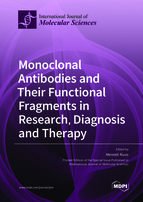Monoclonal Antibodies and Their Functional Fragments in Research, Diagnosis and Therapy
A special issue of International Journal of Molecular Sciences (ISSN 1422-0067). This special issue belongs to the section "Macromolecules".
Deadline for manuscript submissions: closed (30 June 2020) | Viewed by 72802
Special Issue Editor
Interests: monoclonal antibodies; antibody functional fragments; antibody drug conjugates
Special Issues, Collections and Topics in MDPI journals
Special Issue Information
Dear Colleagues,
Monoclonal antibodies (mAbs) are amongst the most specialized molecules deputed to the recognition and capture of specific analytes. Hundreds of thousands of mAbs targeting with ever-increasing affinities and specificities with a vast number of different antigens have been generated and are available for the most diverse purposes. Many of them have been validated as irreplaceable agents for diagnosis and therapy or unique reagents for research. Others are being developed using the plethora of emerging technologies that provide new molecular tools based on antibodies and new antibody formats. This journal issue will try to gather the perspective views and the scientific contributions from several groups specialized in this field, specifically focusing on the generation of new monoclonal antibodies or surrogates, like Fabs, Fab2, ScFv, and nanobodies, which may have an impact as novel therapeutic or diagnostic assets in several diseases.
Dr. Menotti Ruvo
Guest Editor
Manuscript Submission Information
Manuscripts should be submitted online at www.mdpi.com by registering and logging in to this website. Once you are registered, click here to go to the submission form. Manuscripts can be submitted until the deadline. All submissions that pass pre-check are peer-reviewed. Accepted papers will be published continuously in the journal (as soon as accepted) and will be listed together on the special issue website. Research articles, review articles as well as short communications are invited. For planned papers, a title and short abstract (about 100 words) can be sent to the Editorial Office for announcement on this website.
Submitted manuscripts should not have been published previously, nor be under consideration for publication elsewhere (except conference proceedings papers). All manuscripts are thoroughly refereed through a single-blind peer-review process. A guide for authors and other relevant information for submission of manuscripts is available on the Instructions for Authors page. International Journal of Molecular Sciences is an international peer-reviewed open access semimonthly journal published by MDPI.
Please visit the Instructions for Authors page before submitting a manuscript. There is an Article Processing Charge (APC) for publication in this open access journal. For details about the APC please see here. Submitted papers should be well formatted and use good English. Authors may use MDPI's English editing service prior to publication or during author revisions.
Keywords
- Mabs
- Fabs
- ScFv
- nanobodies
- biomarker detection
- bispecific antibodies
- analyte detection
- sandwich assays
Related Special Issues
- Monoclonal Antibodies and Their Functional Fragments in Research, Diagnosis and Therapy 2.0 in International Journal of Molecular Sciences (6 articles)
- Monoclonal Antibodies and Their Functional Fragments in Research, Diagnosis and Therapy 3.0 in International Journal of Molecular Sciences (2 articles)







